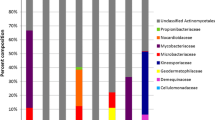Abstract
Deep-sea soft sediments from trench systems and depths in the northwestern Pacific Ocean ranging from less than 300 to 10 897 m in depth have been analyzed for three target genera of actinomycetes: Micromonospora, Rhodococcus, and Streptomyces. Only culturable strains, recovered at atmospheric pressure on selective isolation media, have been examined to date. Maximum recoveries of culturable bacteria were greater that 107/ml wet g sediment, but actinomycetes comprised a small proportion of this population (usually less than 1%). The target actinomycetes were isolated at all depths except from the Mariana Trench sediments. Actinomycete colonies were defined initially on the basis of colony morphologies, and preliminary identification then was made by chemotaxonomic tests. Pyrolysis mass spectrometry (PyMS) of deep-sea mycolic acid-containing actinomycetes gave excellent correspondence with numerical (phenetic) taxonomic analyses and subsequently was adopted as a rapid procedure for assessing taxonomic diversity. PyMS analysis enabled several clusters of deep-sea rhodococci to be distinguished that are quite distinct from all type strains. 16S rRNA gene sequence analysis has revealed that several of these marine rhodococci have sequences that are very similar to certain terrestrial species of Rhodococcus and to Dietzia. There is evidence for the intrusion of terrestrial runoff into these deep trench systems, and the inconsistency of the phenotypic and molecular taxonomies may reflect recent speciation events in actinomycetes under the high-pressure conditions of the deep sea. The results of DNA-DNA pairing experiments point to the novelty of Rhodococcus strains recovered from hadal depths in the Izu Bonin Trench. Biotransformation studies of deep-sea bacteria have focused on nitrile compounds. Nitrile-metabolizing bacteria, closely related to rhodococci, have been isolated that grow well at low temperature, high salt concentrations, and high pressures, suggesting that they are of marine origin or have adapted to the deep-sea environment.
Similar content being viewed by others
Author information
Authors and Affiliations
Additional information
Received: January 22, 1998 / Accepted: February 16, 1998
Rights and permissions
About this article
Cite this article
Colquhoun, J., Heald, S., Li, L. et al. Taxonomy and biotransformation activities of some deep-sea actinomycetes. Extremophiles 2, 269–277 (1998). https://doi.org/10.1007/s007920050069
Issue Date:
DOI: https://doi.org/10.1007/s007920050069




